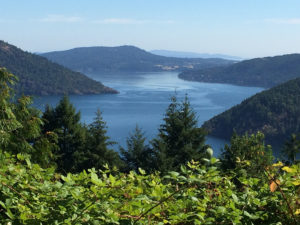Nitrite-oxidizing bacteria have bigger role in marine carbon cycle than previously thought
The Science

View of Saanich Inlet – one of the areas sampled for this study – from Malahat. (BC Ministry of Transportation, Flickr CC BY-NC-ND 2.0)
Researchers have identified the most abundant and globally distributed nitrite-oxidizing bacteria (NOB) in the oceans, through single-cell genomics and community meta-omics. They have also calculated the NOB’s contribution toward trapping carbon beneath the sunlit waters and determined that though these bacteria account for less than 5 percent of the populations in each of the various levels of the so-called “dark ocean,” they capture, or “fix,” close to half of the inorganic carbon in the waters.
The Impact
Most of the ocean is shrouded in darkness. Sunlight only penetrates the first 200 meters of the ocean waters and no light reaches the water deeper than 1,000 meters. This “dark ocean” is estimated to be 90 percent of the ocean’s volume, though very little is known about the microbes that are involved in trapping and utilizing the carbon that reaches these regions, keeping it out of the planet’s atmosphere. This study indicates nitrite-oxidizing bacteria in the dark ocean may have a much greater role in the carbon cycle than previously understood.
Summary

Samples for this study were collected during scientific cruises including one on the R/V Pelagia, a research vessel from the Nederlands Instituut voor Zeeonderzoek Netherlands Institute for Sea Research (NIOZ). (Wikimedia Commons CC BY-SA 3.0)
Beneath the ocean’s surface, the sun’s rays can only go so far. Some light reaches the mesopelagic region, which lies 200 meters-1,000 meters beneath the waters, but no light reaches the bathypelagic (1,000 meters-4,000 meters) or abyssopelagic (4,000 meters-6,000 meters) regions. Despite the lack of sunlight, these waters are teeming with microbial life and contribute significantly to regulating the planet’s global cycles. In the November 24, 2017 issue of Science, a team led by Bigelow Laboratory for Ocean Sciences researchers and including scientists at the Joint Genome Institute, a DOE Office of Science User Facility, generated and analyzed nearly 3,500 single amplified genomes (SAGs) of bacteria and archaea from some 40 samples collected from around the world. The work was enabled in part by the JGI’s Community Science Program. From these SAGs, they identified over a hundred nitrite-oxidizing bacteria (NOB), with the bulk belonging to the Nitrospinae phylum and a handful belonging to the Nitrospirae phylum. The results indicated that these are the predominant NOB in the ocean. Additionally, based on the partial NOB genomes the team assembled, they found genes with the capacity for carbon fixation, indicating these bacteria are involved in regulating the carbon cycle, and genes suggesting that the NOBs are strictly specialized, producing energy solely from nitrite oxidation.
Finally, the team extrapolated the amount of carbon fixed by NOBs, based on the amounts of dissolved inorganic carbon from incubated samples and scaling that calculation to the volume of the ocean’s mesopelagic region where the largest concentration of NOBs are found. Their calculations suggest that NOBs capture as much as 1 Petagram (1 billion metric tons) of carbon annually; this is similar to prior estimates of the total carbon fixation in the dark ocean and indicates that NOBs play a much larger role in regulating the marine carbon cycle than previously thought.
BER Contact
Daniel Drell, Ph.D.
Program Manager
Biological Systems Sciences Division
Office of Biological and Environmental Research
Office of Science
US Department of Energy
[email protected]
PI Contacts
Tanja Woyke
Microbial Program Head
DOE Joint Genome Institute
[email protected]
Ramunas Stepanauskas
Senior Research Scientist
Director of the Bigelow Laboratory Single Cell Genomics Center
[email protected]
Funding
This research was supported by the National Science Foundation, the Austrian Science Fund and the European Research Council. The work conducted by the U.S. Department of Energy Joint Genome Institute is supported by the Office of Science of the U.S. Department of Energy under Contract No. DE-AC02-05CH11231. Aspects of this work were performed under the auspices of the G. Unger Vetlesen and Ambrose Monell Foundations, the Tula Foundation-funded Centre for Microbial Diversity and Evolution, the Natural Sciences and Engineering Research Council of Canada, the Canada Foundation for Innovation, and the Canadian Institute for Advanced Research. Funding was also provided by the Japan Society for the Promotion of Science and French ANR grant Evoldeep.
Publication
- Pachiadaki MG et al. Major role of nitrite-oxidizing bacteria in dark ocean carbon fixation. Science. 2017 November 24. doi:10.1126/science.aan8260.
Related Links
- JGI News Release: Up from the Depths: How Bacteria Capture Carbon in the “Twilight Zone”
- JGI 2012 Community Science Program (CSP) Proposal: Dark ocean microbial single cell genomics
- JGI Community Science Program
- Why Mine Microbial Dark Matter?
- JGI Science Highlight: Streamlining a Common Survival Strategy in Marine Microbes
- JGI 2014 CSP Proposal: Microbial Dark Matter project phase II – stepping deeper into unknown territory
- JGI 2017 CSP Proposal: Expanding the dark matter reference catalog by targeting taxonomic blind spots